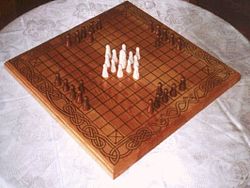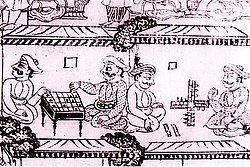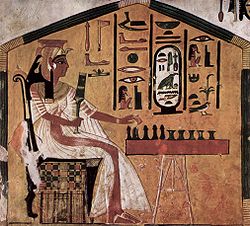Board game
A board game is a game usually played with pieces on a board, or some area with marked spaces.
Most board games use pieces that may be moved, placed, or traded depending on the rules of the game. These pieces may be money, chips, pawns, or other objects. Board games may often involve some random chance with dice or cards. There are many board games with a long history in some cultures. Examples of these games are chess, checkers, backgammon, parqués, and go. There are also a great number of popular board games that have been created more recently, in the past hundred years. Among these games are Scrabble, Monopoly and Sorry!.[1]
Chess, and most versions of checkers, are played on a 8x8 square board with 32 white squares and 32 black squares. International checkers is played on a 10x10 square board.[2]
Older than chess, but not by much, is tafl (pronounced 'tabl'), later called "hneftafl". This is an old Norse board game with just two types of pieces.[3][4] Its pieces, when found in Britain, have often been wrongly ascribed to chess. In chess, of course, the board is different, and there are six kinds of pieces.
Board Game Media
The board game Monopoly is licensed in 103 countries and printed in 37 languages.
The number of board games published by year (1944–2017), as listed on BoardGameGeek. Expansion sets for existing games are marked in orange.
Two Qataris playing the traditional board game of damah
The modern German board game Catan is printed in 30 languages and sold 15 million by 2009.
Mehen game with game stones, from Abydos, Egypt, 3000 BC, Neues Museum
Painting in tomb of Egyptian queen Nefertari (1295–1255 BC) playing senet
References
- ↑ They get initial capitals because they are propriety names, not common names.
- ↑ "International Checkers Rules". Retrieved 2015-02-25.
- ↑ Murray H.J.R. 1913. A history of chess, p445, Hnefatafl. Oxford University Press.
- ↑ Murray H.J.R. 1951. A history of board games other than chess, p56 et seq: Tafl and hnefatafl.
Other websites
| Wikimedia Commons has media related to Lua error in Module:Commons_link at line 62: attempt to index field 'wikibase' (a nil value).. |










